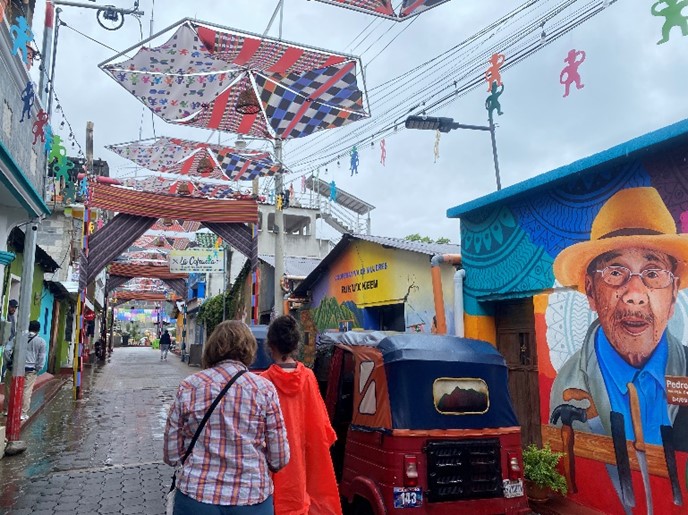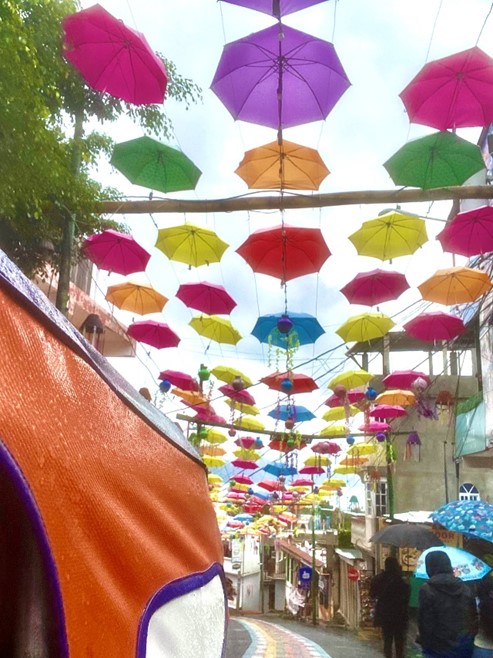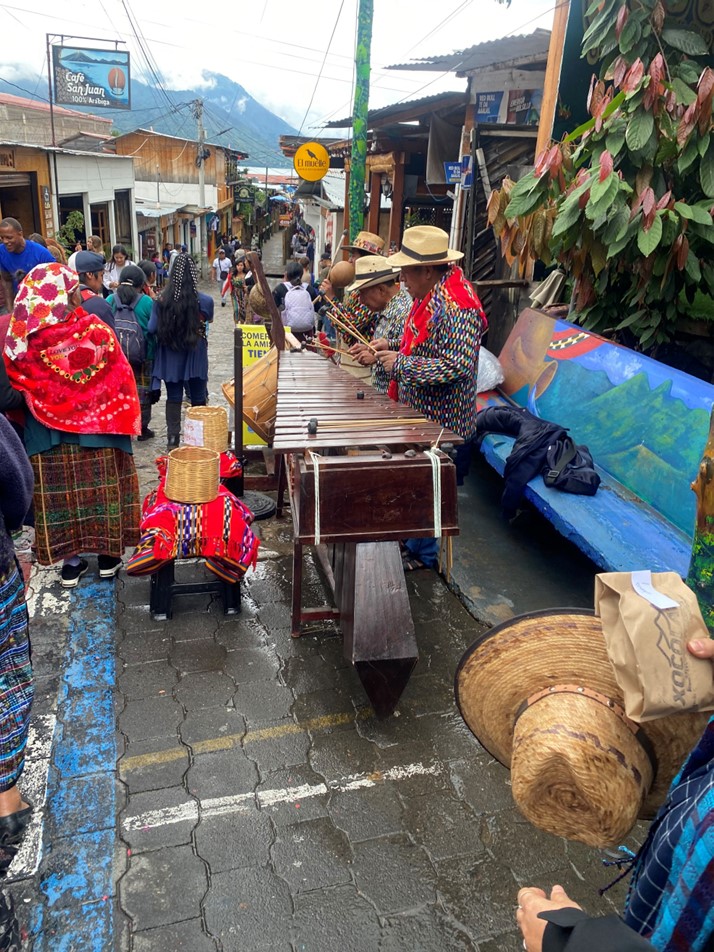by Robert Spillar
I just returned to the United States from a trip to Guatemala, sponsored by my church Shepherd of the Hills, and by our partner organization in Guatemala ILAG (Inglesia Lutherana Agustine de Guatemala). Together, these organizations support a network of indigenous Mayan communities, many of which continue to recover from the disruptive Guatemalan Civil wars that continued up until 1996.
I identify as a “recovering City Traffic Engineer” with experience having served in lead transportation engineering capacities for both public and private entities. As Director of Transportation in Austin and as the City Traffic Engineer in Seattle, I had the privilege of helping to shape the multimodal transportation systems in both cities. So, when I travel to another country, my mind naturally wonders “What would I do here?” if asked to solve the transportation challenges I observe. It’s a bad habit I recognize and try to curb (pun intended), but in the case of Guatemala, where there are so many needs it was hard to suppress my tendency to offer solutions.
Examining Guatemala with a first-world perspective will lead travelers and engineers to quickly see the many infrastructure challenges faced by local residents. Roadways are largely inadequate for the travel demands of moving people and freight long distances across the country (our trip distance into the village of Aurora 8 de Octubre was around 200 km but took all day and traversed 135 locally-installed speed bumps, making travel slow and arduous). Much of the terrain is mountainous, resulting in narrow roadways traversing steep mountain slopes with loose volcanic soil conditions that result in frequent landslides and vegetative intrusions onto the travelway. Drainage systems meant to preserve roadway integrity are easily overwhelmed by tropical precipitation.

Aurora Ocho de Octubre, Guatemala
Public transportation systems between communities are largely privatized in the form of “chicken buses” or reclaimed school busses, rebuilt with oversized engines and suspension that speed along the roadways stopping on-demand to embark and deposit passengers at what often look to be footpaths cut into the surrounding jungle. Where the pavement ends, roads into Indigenous communities are often two-track muddy pathways, best accessed on foot, motorcycle, or rugged off-road truck. Urban streets and thoroughfares in larger communities often must serve as outdoor market and civic plaza while still carrying the private vehicle, horse-drawn cart, or large truck all at once.
The Other Story
There is another story though, one of ingenuity, pride in community, and urban success that can be seen when the traveler lets go of their first-world bias. That story reflects the pride in community of the people living and thriving in towns and cities throughout Guatemala. It reflects creative local governments implementing programs and infrastructure that work for their residents creating local vibrancy and sustainability. Some of these civic approaches are directly transferrable to first-world cities like Austin. Of course, these ideas require translation to our own first-world infrastructure realities, but they present thoughtful strategies for creating place and opportunity on urban streets. In the US, many of our streetscapes have suffered due to pandemic apathy and abandonment. What I found in Guatemala was a teaming urban environment, thriving with pedestrian activity, urban vibrancy, and commercial enterprise.

San Juan La Laguna, Guatemala
In addition to Aurora, I visited the town of San Juan La Laguna on the shores of Lake Atitlan. Arriving by way of water ferry, the village stretches upwards on the steep slopes of a volcano whose crater forms the lake. Cobblestone and brick streets climb grades easily approaching 10-to-12 percent in grade and are often very narrow (maybe 6 meters in width – 20 feet). These streets, by their very nature, are largely pedestrian or accessible by public tuck-tuck taxis. Freight is delivered by cart, small European-style trucks, or hand-carried. More importantly, these streets function as gathering places and shop fronts for commerce – a concept sometimes forgotten in the US where we have unilaterally declared the purpose of the street to be the movement of vehicles from one place to another. Here in Guatemala, I was reminded that first and foremost the street is a place for the community to gather and conduct the commerce of life.

San Juan La Laguna, Guatemala
The municipal authorities in San Juan La Laguna clearly understand the purpose of the local street system in creating place. They have created exciting environments for their residents to gather and celebrate their community, using common articles such as umbrellas and canopies to frame public space on the street. They have used murals and art to create eye candy to cause the pedestrian to linger. They have banned or blocked unauthorized motor vehicles from key alleyways and streets to maintain pedestrian safety and more importantly, remove the distraction of the automobile, allowing the community to integrate shops and retail directly onto the street.
As communities across the US seek to reclaim their urban cores, streetscapes, and town plazas and attract people out of their pandemic cocoons, they could learn much from those in Guatemala about activating urban spaces and doing so on a relatively tight budget. It begins by realizing that the purpose of any urban street is to drive economic activity. Sure, part of that economic activity is derived from the roadway providing for the efficient movement of goods and services, but it can also be about creating commercial activity, supporting sidewalk cafes, and activating community imagination.
Although the urban streetscape pictures shown as part of this article are from the town of San Juan La Laguna, the scenes of active placemaking were repeated in nearly every thriving town or village we encountered. For example, of the 135 speed bumps on my van trip to the village of Aurora, I observed that at nearly every one of them was a thriving market stall benefitting from the forced slowing down of the passing traffic and the natural opportunity and need to sell local products. I suspect that at least some of those speed humps were placed as economic generators (i.e., placemaking) rather than out of a concern about safety.

San Juan La Laguna, Guatemala
Why are the streets in Guatemala teaming with activity while many urban streets in the US largely still resemble post-pandemic ghost towns? I believe it’s because Guatemalan communities are designed to meet the needs of a pedestrian-oriented population. This means on-street presence for retail and restaurant activities is critical to the success of the associated businesses and in fact the community at large. It means that the people feel secure in mingling with what vehicles do attempt to pass through crowded streets because vehicle speeds are necessarily slow. As a result, community leaders respond to this positive economic activity by adding color and art to the streets to create truly exciting places for their residents and visitors.
In these communities, it was easy to spot the American or European visitor. Besides being much taller than the locals, they were the ones pointing at the street art, taking pictures, and generally looking to be truly enjoying themselves within the vibrancy of the urban streetscape. The locals were the ones focused on the business of the day – buying commodities, eating from a street vendor, or seeking to sell their wares to the wandering tourist or local shopper.
As a world traveler, I often have the opportunity to overhear other US travelers from American Cities talk about what they love when they travel. Often their favorite stories are about the street trolly they rode in Lisbon, the biking adventure they took in Amsterdam, or the busy street market they visited in Central America. Yet, as an urban transportation practitioner, I can say that implementing these same infrastructure ideas (urban street trolleys, robust bike networks, and streets designed for pedestrian and commercial activity) are often met with skepticism or outright opposition when proposed as ways to make cities here in the United States more responsive to the needs of residents. Too often the response is that these attributes won’t be used or that they will get in the way of the efficient movement of people, goods, and services. In reality, if we can learn anything from Guatemalan urban streets – driving activity is not about speed and efficiency, it is about slowing down and supporting human interaction.
Guatemala has a story to tell in terms of street vibrancy and activity. If the traveler is only looking at their environment through a first-world lens, they’ll miss the lesson to be learned. Sure, the transportation system can be labeled as inefficient. Sure, it takes what seems like forever to get anywhere. And sure the urban infrastructure in most communities in Guatemala is worn and in need of investment. But, when you slow down and pay attention to the community and activity occurring around you on the street – Guatemala has seized on the notion of creating vibrant culturally exciting community on its public streets – an idea that could benefit cities and towns across the US in bringing life back to our communities.

